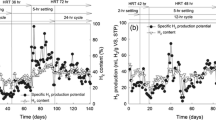Abstract
Anaerobic fermentation of food waste for hydrogen production was performed in serum bottles with various linear alkylbenzene sulfonate (LAS) dosages (7.1–21.4 g/l) and sodium concentrations (5.03–28.7 g/l). LAS can effectively inhibit the activity of hydrogen-consuming bacteria, and the maximum hydrogen yield of 109.2 ml/g volatile solid (VS) was obtained at an LAS dosage of 14.3 g/l without added sodium. The feasible pH for hydrogen production is 5.0–6.0, and the process will slow down or stop when the pH is below 5.0.The hydrogen production potential increased when the sodium concentration increased in the range 5.03–14.41 g/l. The maximum hydrogen yield was 154.8 ml/g VS, and then the hydrogen production began to decrease when the sodium concentration increased further. A sodium chloride concentration of 20 g/l and higher will enhance the osmotic pressure and make bacteria inert. In the effluent, acetic acid is the major by-product. The results indicated that the hydrogen production from the anaerobic fermentation of food waste could clearly be increased with the additives and a sodium concentration less than 20 g/l.
Similar content being viewed by others
References
Das D, Veziroglu TN (2001) Hydrogen production by biological processes: a survey of the literature. Int J Hydrogen Energy 26(1):13–28
Van Ginkel S, Sung S, Lay JJ (2001) Biohydrogen production as a function of pH and substrate concentration. Environ Sci Technol 35:4726–4730
Mizuno O, Dinsdale R, Hawkes FR, Hawkes DL, Noike T (2000) Enhancement of hydrogen production from glucose by nitrogen gas sparging. Bioresour Technol 73(1):59–65
Logan BE, Oh S-E, Kim IS, Van Ginkel S (2002) Biological hydrogen production measured in batch anaerobic respirometers. Environ Sci Technol 36(11):2530–2535
Lay JJ, Lee YJ, Noike T (1999) Feasibility of biological hydrogen production from organic fraction of municipal solid waste. Water Res 33(11):2579–2586
Tanisho S, Ishiwata Y (1995) Continuous hydrogen production from molasses by fermentation using urethane foam as a support of flocks. Int J Hydrogen Energy 20(7):541–545
Ueno Y, Kawai T, Sato S, Otsuka S, Morimoto M (1995) Biological production of hydrogen from cellulose by natural anaerobic microflora. J Ferment Bioeng 79(4):395–397
Okamoto M, Miyahara T, Mizuno O, Noike T (2000) Biological hydrogen potential of materials characteristic of the organic fraction of municipal solids wastes. Water Sci Technol 41(3):25–32
Cai M, Lin J-X, Wei Y-S (2004) Enhanced biohydrogen production from sewage sludge with alkaline pretreatment. Environ Sci Technol 38:3195–3202
Fang HP, Liu H (2002) Effect of pH on hydrogen production from glucose by mixed culture. Bioresour Technol 82:87–93
Sung S, Raskin L, Duangmanee T, Padmasiri S, Simmons JJ (2002) Hydrogen from ammonia and ammonia-borane complex for fuel cell applications In: Proceedings of the 2002 US DOE Hydrogen Program Review, NREL/CO-610-32405
Van Ginkel S, Logan BE (2005) Inhibition of biohydrogen production by undissociated acetic and butyric acids. Environ Sci Technol 39:9351–9356
Zhou QY, Gao TY (2001) Microbiology of environmental engineering. Higher Education Press, Beijing, p 138
Dubois M, Gilles KA, Hamilton JK, Rebers PA, Smith F (1956) Colorimetric method for determination of sugars and related substances. Anal Chem 28:350–356
Khanal SK, Chen WH, Li L, Sung S (2004) Biological hydrogen production: effect of pH and intermediate products. Int J Hydrogen Energy 29:1123–1131
Chen CC, Lin CY, Chang JS (2001) Kinetics of hydrogen production with continuous anaerobic cultures utilizing sucrose as limiting substrate. Appl Microbiol Biotechnol 57:56–64
Collet C, Adler N, Schwirzguebel JP (2001) Hydrogen production by Clostridium thermolacticum during continuous fermentation of lactose. Int J Hydrogen Energy 91:58–63
Liu G, Shen J (2004) Effect of culture medium and medium condition on hydrogen production from starch using anaerobic bacteria. J Biosci Bioeng 68:251–256
Dabrock B, Bahl H, Gottschalk G (1992) Parameters affecting solvent production by Clostridium pasteurianum. Appl Environ Microbiol 58:1233–1239
Fox P, Pohland FG (1994) Anaerobic treatment applications and fundamentals: substrate specificity during phase separation. Water Environ Res 66(5):716–724
Kim S-H, Han S-K, Shin H-S (2004) Feasibility of biohydrogen production by anaerobic co-fermentation of food waste and sewage sludge. Int J Hydrogen Energy 29:1607–1616
Lee Y, Miyahara T, Noike T (2001) Effect of iron concentration on hydrogen fermentation. Bioresour Technol 80:227–231
Author information
Authors and Affiliations
Corresponding author
Rights and permissions
About this article
Cite this article
Cao, X., Zhao, Y. The influence of sodium on biohydrogen production from food waste by anaerobic fermentation. J Mater Cycles Waste Manag 11, 244–250 (2009). https://doi.org/10.1007/s10163-009-0237-5
Received:
Accepted:
Published:
Issue Date:
DOI: https://doi.org/10.1007/s10163-009-0237-5




